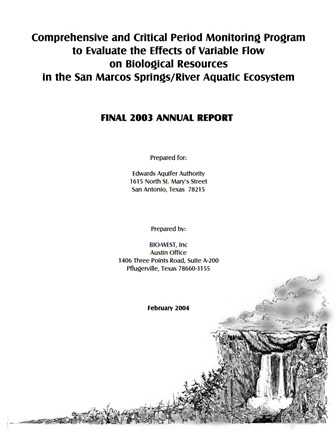Comprehensive and Critical Period Monitoring Program to Evaluate the Effects of Variable Flow on Biological Resources in the San Marcos Springs/River Aquatic Ecosystem Final 2003 Annual Report

| Summary |
|
The purpose of this report is to document the results of all aquatic ecosystem monitoring conducted in 2003 at San Marcos Springs located in San Marcos, Texas. The monitoring and report preparation was performed by BIO-WEST, Inc. Pflugerville, Texas. [Excerpted from Executive Summary] Baseline data have continued to show that the San Marcos River is an ecosystem with high water quality according to the chemical and physical variables that were measured…. Aquatic vegetation remained abundant throughout the study period and provided suitable habitat for biological communities…. As occurred in 2002, there was a substantial increase in total coverage of Texas wild-rice throughout the San Marcos River in 2003 relative to the previous sample. The scouring events in 2001 and 2002 have had a positive long-term impact on Texas wild-rice total coverage… These scouring events appear to stimulate growth of individual stands and also result in displacement of small Texas wild-rice plants, which settle into new areas and grow rapidly. Stands of Texas wild-rice that remain in place after flooding are generally smaller, but they experience rapid growth…. Fountain darters were collected from each sample reach during each sampling event in 2003. The suitability of various vegetation types in the San Marcos River as habitat for fountain darters are similar…. The size-class distribution for fountain darters collected by drop nets from the San Marcos Springs/River ecosystem in 2003 is typical of a healthy fish assemblage. However, the distribution is shifted towards larger fish than those observed in the Comal Springs/River ecosystem and this may be a function of lower quality habitat in the two sampled reaches compared with the Comal River reaches. Also, currents tend to be stronger in the San Marcos River reaches and may contribute to finding larger, but fewer, fish…. In general, the number of fountain darters per net in the San Marcos River was much lower than in the Comal River…. There also appears to be a seasonal trend in fountain darters collected in the San Marcos River of low abundance in the fall and winter with increasing abundance in the spring and into summer. No giant ramshorn snails (Marisa cornuarietis) were observed in the San Marcos River in 2002 or 2003. However, because of the potential for a rapid population increase and the impact that this exotic species can have under heavier densities, close monitoring should continue. The gill parasite that has been reported to infect the fountain darter in the Comal system was not visually evident in fountain darters collected from the San Marcos system in 2003. Estimated population densities of the San Marcos salamander in 2003 were consistent with observations in 2001-2002…. [T]he sample site adjacent to the former Aquarena Springs Hotel consistently had the highest number of San Marcos salamanders…. Population estimates have varied greatly between seasons at each site, overshadowing any seasonal or discharge-related trend that may be present. A lack of substantial lowflow data precludes discussion of potential influences of lower flows on the population at this time…. This study remains the most comprehensive biological evaluation that has ever been conducted on the San Marcos system. |
Search for Documents
Advance Search
Explore EAA's Scientific Reports
- All Reports
- Groundwater Recharge, Recharge Zone
- Groundwater Movement
- Geomorphology and Caves
- Weather Modification
- Geology
- Water Use and Conservation
- Geochemistry
- Water Resources Planning and Management
- Floods and Drought
- Water Quality
- Climatology
- Surface Water / Groundwater Relationship
- Biology
- Springs, Groundwater Discharge
- Archaeology
- RZ Protection
- Aquifer Levels
- Remote Sensing
- Precipitation
- Overview Studies
- Modeling
- Hydrology and Hydrogeology
- History
